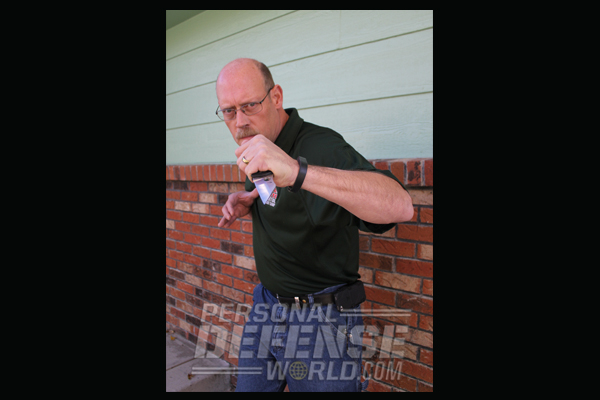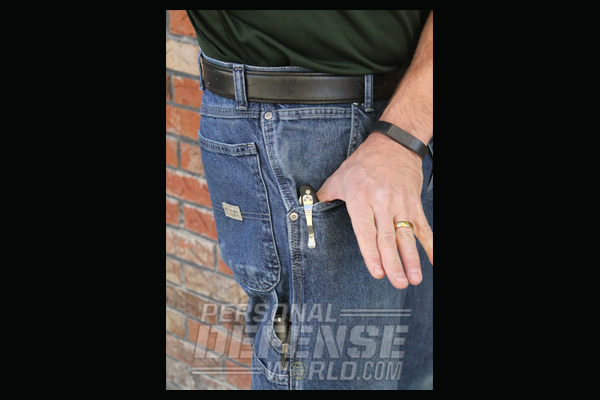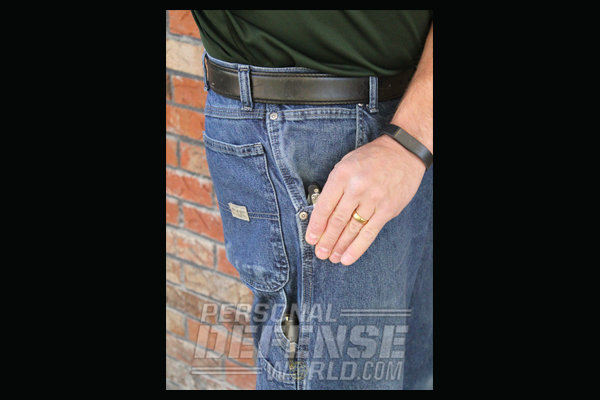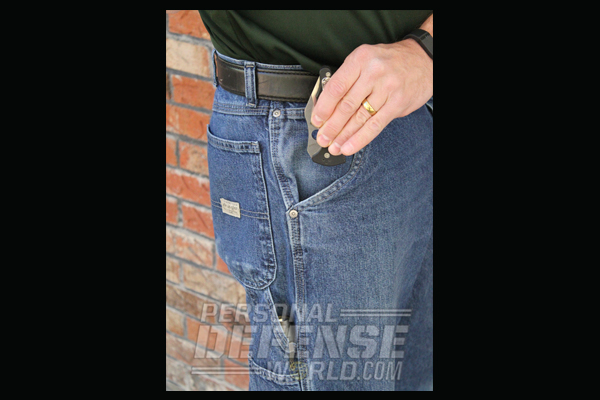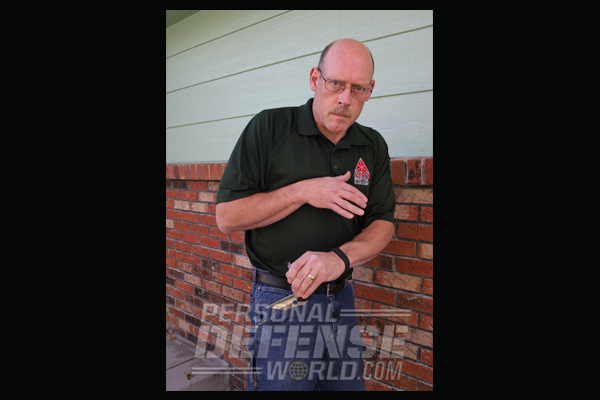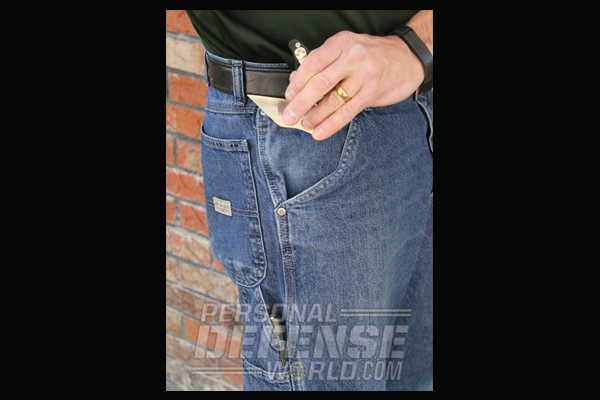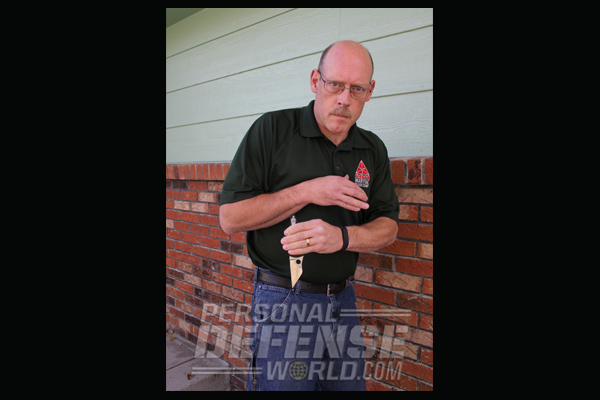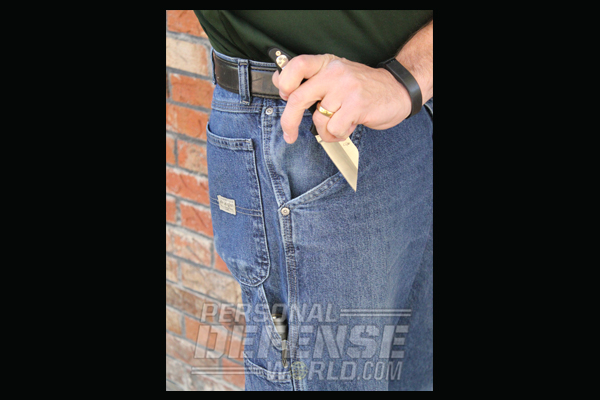To accomplish a weak-hand draw from your strong-side pocket with your non-dominant hand, reach across your body and dig your thumb in deep behind the knife. Grip the clip with your fingertips and lift the knife out of your pocket. Using your ring finger and/or a quick downward snap of your wrist, open the blade. This positions the knife in a reverse grip, an ideal position for quick backhand “Pikal jabs.”
View Image Gallery for a Step-by-Step Visual of How to Execute a Weak-Hand Draw.
Sometimes bad things happen to good people. Despite your best efforts to avoid trouble, it’s possible that you could still be the target of a violent attack. It’s also possible that your dominant hand or arm could be injured during the initial phase of that attack. If that happens and you hope to survive, you need to have solid weak-hand fighting skills.
Advertisement — Continue Reading Below
To shooters, weak-hand skills are nothing new. All sound defensive shooting programs include them. However, many students of knife tactics have never even thought about weak-handed skills, let alone practiced them. To bridge that gap, let’s consider several different strategic approaches to fighting with the non-dominant hand (NDH—a less pejorative, more encouraging term than “weak” hand).
LIVE-HAND TACTICS
The most basic and easy-to-learn approach to NDH skills is to let it do what it always does. In the Filipino martial arts, the NDH is referred to as the “live hand” because it has a very active role in supporting the actions of the dominant, weapon-wielding hand. Sound Western systems of knife tactics take a similar approach, using the NDH in concert with the weapon hand to check, pass, strike, grab and control. Although it typically plays a supporting role, if the dominant hand is injured or immobilized the NDH can step up and use the same tactics as a primary defense. It can also be used to create opportunities for other natural body weapons—like knees, kicks and headbutts—to finish the fight. Although this empty-hand approach does not actually employ the knife, it definitely makes use of well-trained, knife-related skills.
WEAK-HAND DRAW
If you carry only one knife and your dominant hand is disabled, another option is to draw and fight with it using your NDH. Like a weak-handed draw of a firearm, how you carry your knife has a tremendous impact on your ability to access it and employ it with your NDH. My personal preference for carry of a defensive folder is in the strong-side front pocket in a tip-up orientation. This position allows me to draw, open and apply the knife with a minimum amount of manipulation. I also favor this carry position because it supports a no-frills draw and opening with the NDH.
Advertisement — Continue Reading Below
If we assume that the knife is carried tip-up on the right side and the left hand is the NDH, the draw begins by reaching across in front of your body with your left hand. Depending upon your range of motion and your physique, you may find it helpful to twist your hips to your left as you turn your shoulders to the right. Once your hand reaches your pocket, use it like a funnel and dig your thumb in deep to get lots of surface contact with the handle. Hook your fingertips under the tip of the clip and lift the knife up and out of the pocket. As you do, keep your hand in a natural thumb-up position, which will put the butt of the handle upward. To open the blade, you can either drive down with your ring finger (replicating the action of a thumb opening) or snap your wrist sharply downward to open it by inertia.
Once open, the knife will be in reverse grip in your left hand and perfectly positioned for a “Pikal jab”—a natural, instinctive backhand thrust that has been addressed in previous Street Smarts columns. Basically a rapid-fire “woodpecker” action, it is easy to learn, versatile and easy to perform with the less coordinated NDH.
NON-DOMINANT CARRY
Another approach to NDH tactics is to carry a dedicated knife on the non-dominant side. In addition to making the knife easily accessible to the NDH, this tactic also ensures that you have a backup knife in case you drop your primary one. If you like the crossbody draw and Pikal jab tactic described earlier, you can easily translate this to carry on your non-dominant side. Simply set up your knife for right-side, tip-up carry and then move it to your left pocket. Clipped there, the back of the closed blade will face forward. Dig in deep with your left thumb, hook under the clip and lift—you’re in exactly the same position for a reverse-grip opening of your choice. Another non-dominant-side option is to configure your second knife to carry in the “mirror image” of the dominant side. Your deployment and tactics will also be mirror image, allowing the NDH to learn from the dominant hand. In fact, practicing the mechanics with both hands simultaneously is a great way to achieve this skill. Experiment with all these options and find a solution that works for you. That way if your dominant hand is ever disabled, you’ve still got plenty of fight in the parts that are left.
Advertisement — Continue Reading Below
